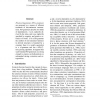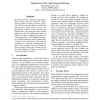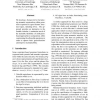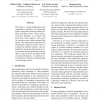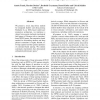ACL
2003
14 years 27 days ago
2003
We augment a model of translation based on re-ordering nodes in syntactic trees in order to allow alignments not conforming to the original tree structure, while keeping computati...
ACL
2003
14 years 27 days ago
2003
This paper presents a dependency language model (DLM) that captures linguistic constraints via a dependency structure, i.e., a set of probabilistic dependencies that express the r...
ACL
2001
14 years 27 days ago
2001
Polarized dependency (PD-) grammars are proposed as a means of efficient treatment of discontinuous constructions. PD-grammars describe two kinds of dependencies : local, explicit...
ACL
2001
14 years 27 days ago
2001
We present a machine learning approach to evaluating the wellformedness of output of a machine translation system, using classifiers that learn to distinguish human reference tran...
ACL
2003
14 years 27 days ago
2003
This paper presents a Chinese word segmentation system that uses improved sourcechannel models of Chinese sentence generation. Chinese words are defined as one of the following fo...
ACL
2001
14 years 27 days ago
2001
We develop a framework for formalizing semantic construction within grammars expressed in typed feature structure logics, including HPSG. The approach provides an alternative to t...
ACL
2003
14 years 27 days ago
2003
We present a domain-independent topic segmentation algorithm for multi-party speech. Our feature-based algorithm combines knowledge about content using a text-based algorithm as a...
ACL
2003
14 years 27 days ago
2003
We present a novel, data-driven method for integrated shallow and deep parsing. Mediated by an XML-based multi-layer annotation architecture, we interleave a robust, but accurate ...
ACL
2001
14 years 27 days ago
2001
We consider the question "How much strong generative power can be squeezed out of a formal system without increasing its weak generative power?" and propose some theoret...
ACL
2003
14 years 27 days ago
2003
Recent work in Question Answering has focused on web-based systems that extract answers using simple lexicosyntactic patterns. We present an alternative strategy in which patterns...

